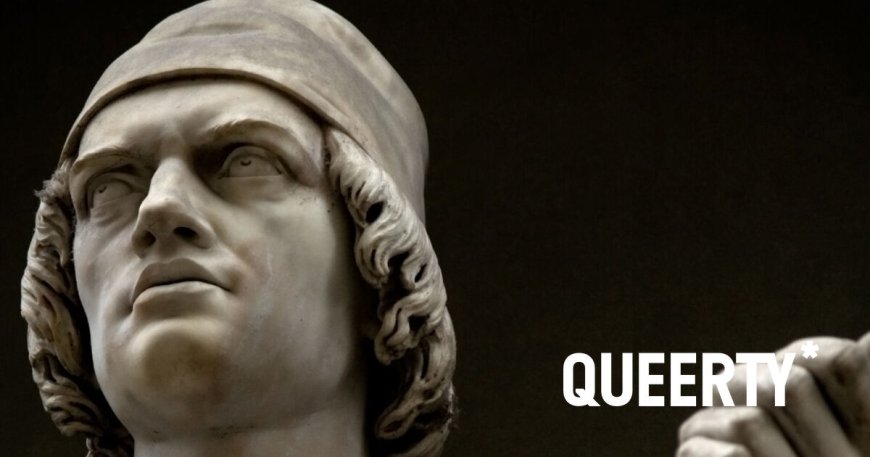The guy who wrote the book on heterosexual marriage & family had some VERY homosexual tendencies
The man who wrote the literal book on heterosexual marriage and the nuclear family, Leon Battista Alberti, couldn't help but get a little queer.


We all know that the Renaissance was queer, with hot, shirtless men appearing in paintings and sculptures everywhere. But did you know even the man who wrote the literal book on heterosexual marriage and the nuclear family, Leon Battista Alberti, couldn’t help but get a little queer?
I libri della famiglia (On the Family) is a treatise about marriage, the nuclear family, how to raise children, and the role of the head of the household. While sexuality was complicated in the 15th century, so we can’t definitively pin a rainbow flag on this talented Renaissance fellow, he’s the definition of queer-coded. Renaissance scholars who focus on Alberti’s writings have frequently discussed his likely homosexuality.

By modern standards, Alberti is a misogynist. Alexa play “Another White Boy With A Podcast.” But social bonding and gender roles were vastly different in the Renaissance, formally coded by men like him, whose writing has long impacted how society thinks about marriage and family.
Art historian Laurie Schneider suggests that even this misogyny may be reflective of his homosexuality. In a series of episodes in one of his books, Intercenales, there is a particularly poignant story where a husband develops a friendship with his wife’s lover. That book also features stories about a love affair and marriage with distinctly homoerotic undertones.
According to Schneider, Alberti’s homosexual identity was deeply connected to a difficult relationship with his father and his family’s exile from Florence for many years. That may be the queerest thing about him.
You know how you have that friend that’s a lawyer and interior designer and life coach and shaman and aspiring hotelier? Alberti was one of those. His list of accomplishments is long. He was an author, artist, architect, poet, linguist, philosopher, and cryptographer.
Oh, and a priest.
His standing as a priest only gave him more authority in writing about the family in, as Trixie Mattel would say, “a God-honoring way.”

If you were queer in the Renaissance, taking a holy order was the best way to get out of your obligation to carry on your family line. At least in devoting one’s life to God, a Renaissance priest could safely love and admire another man, y’know? The Renaissance was not ready for Ariana Grande’s “God is a Woman.”
But God was often not the only man that men found themselves worshipping. The pain and abuse of the Catholic church are real and ongoing, but it was already pronounced in 15th and 16th century Florence. According to historian Michael Rocke, churches were prevalent locations for homosexual dalliances in the Renaissance. Shocker.
There is no direct evidence that Alberti was involved in any sodomy at church or elsewhere, but scholars have repeatedly identified that his writing was filled with homosexual bias, including in his book on family. For instance, Alberti suggests on page 57 of I libri that young boys avoid “female idleness” and “to be bold… about appearing among men.”
Boys were often compared to women and in 1492, so many grown men were having sex with young, beautiful boys that the Florentine governing council actually had to issue a decree specifically asking bathhouse owners to turn away good looking boys to try and curb the problem.

Alberti was tough on young males, claiming that “the volatile youths always pursue their desires; the appetites of youths are insatiable.” This reflected broader social thoughts about boys and young men, believed to be driven by lust from about 14 to 25. In reality, they were shackled to the patriarchal culture of the time, where their fathers decided most of their lives, including who they married and their profession.
Sex with other men wasn’t just a young man’s game. According to Rocke, 1 in 4 cases of sodomy in Florence involved married men, 44% of those cases involving men over 30. It’s hardly surprising, though.
Young, fit men were seen as the epitome of human beauty by people like Alberti and his peers, so the harsh condemnation of his younger counterparts may be because he held them responsible for his and other older men’s attraction towards them.
Alberti was also obsessed with secrets. Like, really obsessed. In I libri, the main character, Gianozzo (Alberti’s metaphorical voice in the text), goes on for pages about the perils of sharing secrets with one’s wife.
According to the narrator, the family’s finances and a husband’s letters are never to be shared with one’s wife because these personal writings and accounts contain many secrets. The other male characters are warned to be weary of wives who want to concern themselves too much with their husband’s affairs. What’s so secret that a man’s wife can’t know?

The polymath even invented his own cipher, the Alberti Cipher, for communicating secret information to trusted confidantes. Clearly, he was a little paranoid about who knew his business. Although Alberti devised the cipher to convey military and religious information, it’s not out of the realm of possibility to think that ciphers could have been used for personal communication between male lovers about meetups or proclamations of love. Parchment, after all, was easily flammable.
I don’t know about you, but I’d watch a two-hour historical romance movie about it on a streaming service.

 Mark
Mark 





